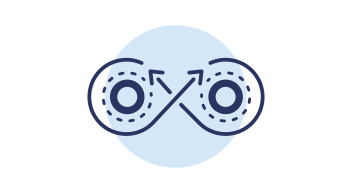A Pragmatic Guide to FinOps

Transforming Cloud Spend into Strategic Value
Many organizations start their cloud journey with a lift-and-shift migration. It’s a fast way to get started and reap immediate benefits. But it often comes with a hidden cost: overprovisioning.
For example, an organization may migrate their hundreds of on-premise servers to Amazon EC2 instances. While the move provides agility and flexibility, the initial cloud spend is high. Engineering grapples with significant costs, a common scenario when legacy systems are moved to the cloud without a focus on cloud-native optimization.
At nvisia, we often see this pattern firsthand when helping clients modernize—cloud migration delivers agility, but without an architecture for financial accountability, costs can quickly spiral.
This challenge isn't unique to lift-and-shift migrations.
It reflects a broader need for what we call a Domain-driven FinOps Review—a structured, architectural approach to aligning financial management with cloud operations to drive long-term modernization and business value.
Other issues that could prompt such a review include a merger or acquisition that brings in a new cloud environment, unexpected spikes in billing due to misconfigurations or rogue applications, or a lack of cost ownership and accountability across engineering teams.
Solution
A common approach to tackling this problem is to partner with your FinOps team to develop a strategy. FinOps isn’t just a reporting function—it’s an architected discipline that brings financial accountability into engineering decisions. Dashboards, for example, should be designed as repeatable playbooks, not just ad hoc reports. A dashboard will often include key features like:
- Recommendations Search: Surfaces AWS Cost Optimization Recommendations, likely sourced from AWS Cost Explorer or AWS Trusted Advisor. These include rightsizing EC2 instances, deleting unused Amazon EBS volumes, and switching to more cost-effective AWS services.
- Cost Anomaly Search: Automatically flags unusual spikes or drops in spending, allowing for quick investigation into potential misconfigurations, unexpected usage, or unauthorized resource creation.
- Chargeback Search: Enables detailed analysis of costs by business criteria such as Cost Center, Cost Center Manager, or Tag Name (tag for application or service names by life-cycle). This is essential for accountability and understanding where costs truly originate.
- Instance Scheduling Search: Highlights potential savings from implementing scheduling for specific services, especially for non-production environments that don't need to run 24/7.
Dashboard searches should support filtering through criteria like Cost Center, Cost Center Manager, Tag Name, Amazon Resource Name (ARN), and Billing Periods. This granular visibility can be the foundation to a playbook for executives seeking both short-term and long-term cost savings.
Playbook for Domain-Driven FinOps Review
Executing a Domain-driven FinOps Review can follow a simple but effective strategy: assign domain leaders a task to analyze each business service in their domain. This structured approach avoids siloed fixes and provides a holistic roadmap for modernization. Domain leaders can create a comprehensive list of all business services, identified by their Tag Name. This tag, applied to resources across lifecycles like dev, quality assurance, user acceptance testing, and production, provides the necessary context for analysis.
For each Tag Name, have domain leaders search for opportunities in these key areas:
- Rightsizing: Examine lower life-cycle services to determine if they are overprovisioned. Rightsizing to smaller, more appropriate instance types can reduce costs without impacting performance.
- Instance Scheduling: Identify services that could benefit from scheduled downtime. For example, could dev environments be turned off during non-working hours or program increments when no development activity is planned?
- Data Archival: Apply archival policies to file systems like Amazon EFS, reducing real-time storage costs by moving less-frequently accessed data to more economical storage tiers.
- Retention Policies: Revisit with business owners whether all historical data is necessary, or if shorter retention periods could lower storage costs.
- Open Source Alternatives: Replace expensive licensed products with open-source solutions where appropriate. But be sure to emphasize careful evaluation of these tradeoffs—not every open-source option is right, but where it aligns, it can deliver both cost savings and architectural flexibility.
- Backup Strategy: Review backup strategies to eliminate unnecessary redundancy and ensure alignment with business needs.
- Estimated Cost Savings: Use the AWS Pricing Calculator to forecast potential savings for each opportunity.
To prioritize which Tag Names to address, domain leaders can implement a scorecard—ranking services by potential cost savings, ease of implementation, and business impact. For example, a Tag Name with high overprovisioning and a clear downtime window earns a high score, making it a prime candidate for a quick win.
Based on the scorecard, the domain leader can create a roadmap for addressing each Tag Name. It's crucial that any changes are applied across the lifecycle—from dev to production—to avoid unexpected issues. Analytics are key here; for example, reducing the number of servers in a cluster requires a stress test to ensure the system can still handle its load.
Conclusion
A Domain-driven FinOps Review can provide a clear, actionable roadmap for each domain in your organization. With proper prioritization, you should begin to see reductions in spend almost immediately. But this exercise is not just about cutting costs. It's about optimizing cloud resources to create strategic business value.
By gaining visibility and implementing a systemic approach, you can transform your cloud spend from a liability into an architected advantage—a foundation for both efficiency and long-term competitive differentiation.
Further reading
- AWS Cost Optimization Pillar - https://docs.aws.amazon.com/wellarchitected/latest/cost-optimization-pillar/cost-optimization.html
- AWS Getting Started with Cost Explorer - https://docs.aws.amazon.com/cost-management/latest/userguide/ce-getting-started.html
- AWS Tag for Cost Allocation and Financial Management - https://docs.aws.amazon.com/whitepapers/latest/tagging-best-practices/tags-for-cost-allocation-and-financial-management.html
- FinOps Foundation Framework - https://www.finops.org/framework/




